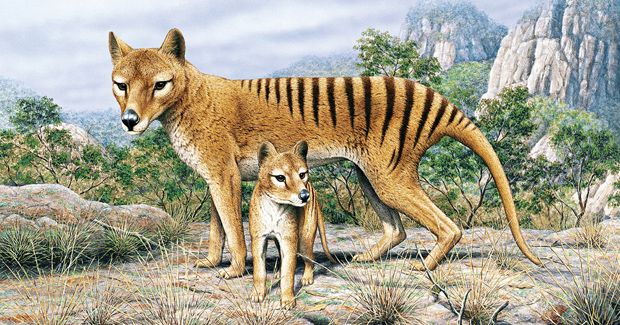Tasmanian Tiger Trainers at the Australian Zoo, by Michelann Settle
 Senior students in Mr. Joel Wilkes English class recently had to write a short essay addressing a topic of their choice. They were required to focus on clarifying a thesis statement, supporting the thesis statement with body paragraphs, and give examples that show their point rather than simply telling it. Below is an example of one of those essays, written by Miss Michelann Settle, class of 2016.
Senior students in Mr. Joel Wilkes English class recently had to write a short essay addressing a topic of their choice. They were required to focus on clarifying a thesis statement, supporting the thesis statement with body paragraphs, and give examples that show their point rather than simply telling it. Below is an example of one of those essays, written by Miss Michelann Settle, class of 2016.
Tasmanian Tiger Trainers at the Australian Zoo
by Michelann Settle
It had been raining all day long. The animal catchers were struggling to keep their eyes open while making their lengthy journey through the rugged Grampian mountains of Victoria, Australia. They had been diligently searching for three days at this point. A combination of stiff muscles and a cool breeze left them feeling almost paralyzed, yet they did not lose heart. They were a young and capable group of men from the Australian Zoo, looking for a species that was so scarce, it had not been seen in a century. Usually, they would be doing other work, on other missions. This mission, however, was an annual honor. Every year they would search a certain region for one month hoping to find the Tasmanian tiger. Also referred to as the Thylacine, these animals were known to be the largest carnivorous marsupials of modern times. Along with other endangered species, the Australian Zoo is willing to go to extreme measures to save these tigers from extinction. They find endangered animals such as these, bring them to a safe environment free of hunters, and show them how to survive to in order to grow as a species. This cool, damp day was the day that the Tasmanian tigers would finally have a chance. These men, though on commission, were more concerned with the safe capture and care of the tigers that they were looking for than the money that they would receive after finding them. Their rugged, yet somehow sturdy safari jeep could hold all four of them and a spacious, comfortable trailer hitched to its rear with room for up to five tigers. The catchers were well prepared to rescue the poor endangered animals, mentally and physically. Their GPS read that they were at their next stop. With a shaky halt, they put the jeep in park, turned it off, and hopped out. Their net guns were strapped securely over their shoulders. After some careful planning in a quiet huddle, they split up and followed separate routes that each led to potential tiger locations. They used CB radios to communicate at this point. Duncan, one of the faithful wildlife preservers, was instructed to head west. With enthusiasm and patience, he was willing to search for hours. All of a sudden, the leaves crumpled behind him. To the left, he heard a soft growl coming from behind the trees. Duncan, trying not to let his adrenaline get the best of him, scanned the area around him while taking deep breaths. As he was turning back to where he started, his eyes witnessed a glorious scene of a four member family of Tasmanian tigers. Though they were shorter than he, they were still intimidating. Just by looking at them, Duncan knew that they were struggling to survive. Their bony figures were accented by the various scars on their coats. Not only did this sight give Duncan a deep obligation to make sure that they were taken care of properly, it also gave him hope that the species still had a chance.
Somehow, Duncan needed to get the tigers back to the trailer. With his eyes set steadily on the tigers, he reached to his shoulder. He was not reaching to his net gun at this point. Instead, he was quietly enlisting help from his fellow catchers by using the CB radio. Thankfully, the men were not far. They came in from different sides of the area, surrounding the tigers. All of the catchers slowly reached for their net guns trying not to scare the ambush. On a synchronized count, the men released their nets, aiming for each individual tiger. One of the catcher's net did not come out. Three tigers were caught while the last was left standing. It was the cub that did not get caught, and it did not know weather it should leave its family and attempt to fend for itself, or stay with them. Its struggle to reach a decision was obvious, as it appeared to be shaking and scared. While everyone was watching this happen, the catcher with the net malfunction was trying to repair his gun before the cub chose to leave. His hands were so shaky that he was taking twice as long as he usually would to make a repair. At last, he fixed his gun and immediately shot his net at the cub. Finally, they had successfully caught all four tigers. It was hard for them to do so, as wildlife preserves, seeing that the tigers were so uncomfortable. The men resolved to give each of them tranquilizing shots for their own peace on the ride back. This part of the process was Duncan's least favorite due its inhumane reputation. At the same time, Duncan knew that taking them to a safe place was the best option.
The catchers were excited and honored to have found such a rare, endangered species. Not only did they find an animal that had not been seen in a century, but they had found a whole family of them. Carefully, they carried the sleeping tigers to the jeep and loaded them into the trailer. Five hours later, they arrived the zoo. The staff, though overjoyed because of this discovery and rescue, knew that the tigers needed immediate medical attention. Multiple tests were done and various shots were given to them. It was very helpful that they were still unconscious, making it easier for both the workers and the tigers as they were being taken care of. By this point, it was almost four o'clock in the morning. The catchers and staff were motivated to keep on going due to their overall dedication to save the tigers. It had been a difficult and intimidating task, especially year after year, to go searching for an animal that was suspected to be extinct. Thanks to these four hard-workers, those suspicions were proven to be wrong, and the tigers were finally given a chance to thrive as a species.
Before the tigers woke up, the weak and tired men took them to their new home. It was a luxurious place for a Tasmanian tiger. They could run as much as they wanted to in their vast area of two thousand square feet. Their diverse terrain offered a variety of places to play. Being in this new environment, where their well being was not threatened anymore, they could finally be at rest. Most importantly, they would now always be fed. One could tell just by looking at them when they first arrived to the zoo that they were severely malnourished. It is difficult to say whether or not there may be others out there. Likewise, It was a miracle that this family had survived together in the wild. Now it was easy for the catchers and staff to rest because they knew that these animals were safe, sound, and happy in their exhibit.
Duncan and his friends developed close bonds with the tigers from the very beginning. They fed them, trained them, and spent time around their cage. The tigers' trust for the men became strong. They certainly are not the type of animal to be domesticated; however, they were smart and had distinct personalities. For example, the youngest was an energetic cub who always let out a roar for Duncan to feed him the same time every day. Duncan became fond of the cub, and even named him Nigel. Being an animal trainer as well as a catcher, Duncan taught Nigel dozens of tricks. He would reward and punish him by giving positive and negative attention appropriately. When Nigel would do something wrong, like a good father who loves his child, Duncan would discipline him. The harshest thing that the trainers could do to them was spray them with water. If the tiger needed further discipline, they would take up measures that were more serious, always keeping its safety in mind. Duncan would also sing to Nigel, which is something one might not expect. Like Duncan and Nigel, other trainers grew close to the tigers as well. They all wanted to make the tigers feel as comfortable and loved as possible.
As the years went by, the number of tigers increased as did their treatment. The zoo wanted to let the tigers continue to raise their packs in the wild. With this desire in mind, the trainers picked two tigers, male and female, and placed them in a separate exhibit. In this large exhibit, their goal was to prepare the tigers for the wild. They were exposed to other animals and had to find food on their own. If they were struggling, the trainers would help them by providing the proper resources. At the same time, they wanted the tigers to be ready for the wild. After a few months of studying their lifestyle and steadily developing independence, the trainers released the two into the wild. It was sad to let them go, but the tigers were ready. It was good for them to be released in the wild for the sake of growing the species; and hopefully now, they would thrive over the hundreds of years to come, starting with the two of them.
By this point, the trainers knew that they had done their job. They had found an endangered species, given them a chance to grow, and let them return to their natural habitat. The lives of the remaining tigers would certainly still be catered to. At the same time, the trainers' appreciation and care for them would be strengthened. Some people wonder if any zookeepers actually care about the animals they are supposed to take care of. If you happen to know one of those people, tell them about the Tasmanian tiger trainers at the Australian Zoo.
